SLAS734G April 2011 – April 2016 MSP430G2203 , MSP430G2233 , MSP430G2303 , MSP430G2333 , MSP430G2403 , MSP430G2433 , MSP430G2533
PRODUCTION DATA.
- 1Device Overview
- 2Revision History
- 3Device Comparison
- 4Terminal Configuration and Functions
-
5Specifications
- 5.1 Absolute Maximum Ratings
- 5.2 ESD Ratings
- 5.3 Recommended Operating Conditions
- 5.4 Active Mode Supply Current Into VCC Excluding External Current
- 5.5 Typical Characteristics, Active Mode Supply Current (Into VCC)
- 5.6 Low-Power Mode Supply Currents (Into VCC) Excluding External Current
- 5.7 Typical Characteristics, Low-Power Mode Supply Currents
- 5.8 Thermal Resistance Characteristics
- 5.9 Schmitt-Trigger Inputs, Ports Px
- 5.10 Leakage Current, Ports Px
- 5.11 Outputs, Ports Px
- 5.12 Output Frequency, Ports Px
- 5.13 Typical Characteristics - Outputs
- 5.14 Pin-Oscillator Frequency - Ports Px
- 5.15 Typical Characteristics - Pin-Oscillator Frequency
- 5.16 POR, BOR
- 5.17 Main DCO Characteristics
- 5.18 DCO Frequency
- 5.19 Calibrated DCO Frequencies, Tolerance
- 5.20 Wake-up Times From Lower-Power Modes (LPM3, LPM4)
- 5.21 Typical Characteristics, DCO Clock Wake-up Time From LPM3 or LPM4
- 5.22 Crystal Oscillator, XT1, Low-Frequency Mode
- 5.23 Internal Very-Low-Power Low-Frequency Oscillator (VLO)
- 5.24 Timer_A
- 5.25 USCI (UART Mode)
- 5.26 USCI (SPI Master Mode)
- 5.27 USCI (SPI Slave Mode)
- 5.28 USCI (I2C Mode)
- 5.29 10-Bit ADC, Power Supply and Input Range Conditions (MSP430G2x33 Only)
- 5.30 10-Bit ADC, Built-In Voltage Reference (MSP430G2x33 Only)
- 5.31 10-Bit ADC, External Reference (MSP430G2x33 Only)
- 5.32 10-Bit ADC, Timing Parameters (MSP430G2x33 Only)
- 5.33 10-Bit ADC, Linearity Parameters (MSP430G2x33 Only)
- 5.34 10-Bit ADC, Temperature Sensor and Built-In VMID (MSP430G2x33 Only)
- 5.35 Flash Memory
- 5.36 RAM
- 5.37 JTAG and Spy-Bi-Wire Interface
- 5.38 JTAG Fuse
-
6Detailed Description
- 6.1 CPU
- 6.2 Instruction Set
- 6.3 Operating Modes
- 6.4 Interrupt Vector Addresses
- 6.5 Special Function Registers (SFRs)
- 6.6 Memory Organization
- 6.7 Bootloader (BSL)
- 6.8 Flash Memory
- 6.9 Peripherals
- 6.10
I/O Port Diagrams
- 6.10.1 Port P1 Pin Diagram: P1.0 to P1.2, Input/Output With Schmitt Trigger
- 6.10.2 Port P1 Pin Diagram: P1.3, Input/Output With Schmitt Trigger
- 6.10.3 Port P1 Pin Diagram: P1.4, Input/Output With Schmitt Trigger
- 6.10.4 Port P1 Pin Diagram: P1.5 to P1.7, Input/Output With Schmitt Trigger
- 6.10.5 Port P2 Pin Diagram: P2.0 to P2.5, Input/Output With Schmitt Trigger
- 6.10.6 Port P2 Pin Diagram: P2.6, Input/Output With Schmitt Trigger
- 6.10.7 Port P2 Pin Diagram: P2.7, Input/Output With Schmitt Trigger
- 6.10.8 Port P3 Pin Diagram: P3.0 to P3.7, Input/Output With Schmitt Trigger (RHB and PW28 Package Only)
- 7Device and Documentation Support
- 8Mechanical, Packaging, and Orderable Information
パッケージ・オプション
メカニカル・データ(パッケージ|ピン)
サーマルパッド・メカニカル・データ
発注情報
6 Detailed Description
6.1 CPU
The MSP430 CPU has a 16-bit RISC architecture that is highly transparent to the application. All operations, other than program-flow instructions, are performed as register operations in conjunction with seven addressing modes for source operand and four addressing modes for destination operand.
The CPU is integrated with 16 registers that provide reduced instruction execution time. The register-to-register operation execution time is one cycle of the CPU clock. Four of the registers, R0 to R3, are dedicated as program counter, stack pointer, status register, and constant generator, respectively. The remaining registers are general-purpose registers (see Figure 6-1).
Peripherals are connected to the CPU using data, address, and control buses, and can be handled with all instructions.
The instruction set consists of the original 51 instructions with three formats and seven address modes and additional instructions for the expanded address range. Each instruction can operate on word and byte data.
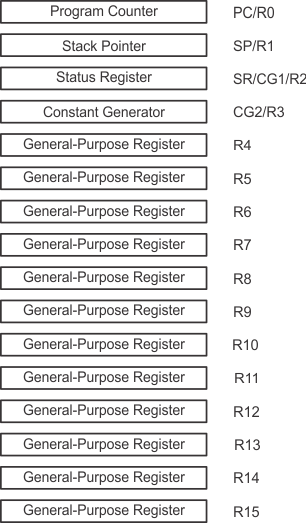 Figure 6-1 Integrated CPU Registers
Figure 6-1 Integrated CPU Registers
6.2 Instruction Set
The instruction set consists of 51 instructions with three formats and seven address modes. Each instruction can operate on word and byte data. Table 6-1 lists examples of the three types of instruction formats. Table 6-2 lists the address modes.
Table 6-1 Instruction Word Formats
| INSTRUCTION FORMAT | EXAMPLE | OPERATION |
|---|---|---|
| Dual operands, source-destination | ADD R4,R5 | R4 + R5 → R5 |
| Single operands, destination only | CALL R8 | PC → (TOS), R8 → PC |
| Relative jump, unconditional or conditional | JNE | Jump-on-equal bit = 0 |
Table 6-2 Address Mode Descriptions
| ADDRESS MODE | S(1) | D | SYNTAX | EXAMPLE | OPERATION |
|---|---|---|---|---|---|
| Register | ✓ | ✓ | MOV Rs,Rd | MOV R10,R11 | R10 → R11 |
| Indexed | ✓ | ✓ | MOV X(Rn),Y(Rm) | MOV 2(R5),6(R6) | M(2+R5) → M(6+R6) |
| Symbolic (PC relative) | ✓ | ✓ | MOV EDE,TONI | M(EDE) → M(TONI) | |
| Absolute | ✓ | ✓ | MOV &MEM,&TCDAT | M(MEM) → M(TCDAT) | |
| Indirect | ✓ | MOV @Rn,Y(Rm) | MOV @R10,Tab(R6) | M(R10) → M(Tab+R6) | |
| Indirect autoincrement | ✓ | MOV @Rn+,Rm | MOV @R10+,R11 | M(R10) → R11 R10 + 2 → R10 |
|
| Immediate | ✓ | MOV #X,TONI | MOV #45,TONI | #45 → M(TONI) |
6.3 Operating Modes
These microcontrollers have one active mode and five software-selectable low-power modes of operation. An interrupt event can wake the device from any of the low-power modes, service the request, and restore back to the low-power mode on return from the interrupt program.
Software can configure the following operating modes:
- Active mode (AM)
- All clocks are active
- Low-power mode 0 (LPM0)
- CPU is disabled
- ACLK and SMCLK remain active, MCLK is disabled
- Low-power mode 1 (LPM1)
- CPU is disabled
- ACLK and SMCLK remain active, MCLK is disabled
- DC generator of the DCO is disabled if DCO not used in active mode
- Low-power mode 2 (LPM2)
- CPU is disabled
- MCLK and SMCLK are disabled
- DC generator of the DCO remains enabled
- ACLK remains active
- Low-power mode 3 (LPM3)
- CPU is disabled
- MCLK and SMCLK are disabled
- DC generator of the DCO is disabled
- ACLK remains active
- Low-power mode 4 (LPM4)
- CPU is disabled
- ACLK is disabled
- MCLK and SMCLK are disabled
- DC generator of the DCO is disabled
- Crystal oscillator is stopped
6.4 Interrupt Vector Addresses
The interrupt vectors and the power-up starting address are in the address range 0FFFFh to 0FFC0h (see Table 6-3). The vector contains the 16-bit address of the appropriate interrupt handler instruction sequence.
If the reset vector (at address 0FFFEh) contains 0FFFFh (for example, if the flash is not programmed), the CPU goes into LPM4 immediately after power-up.
Table 6-3 Interrupt Sources, Flags, and Vectors
| INTERRUPT SOURCE | INTERRUPT FLAG | SYSTEM INTERRUPT | WORD ADDRESS | PRIORITY |
|---|---|---|---|---|
| Power up External reset Watchdog Timer+ Flash key violation PC out of range(1) |
PORIFG RSTIFG WDTIFG KEYV(2) |
Reset | 0FFFEh | 31, highest |
| NMI Oscillator fault Flash memory access violation |
NMIIFG OFIFG ACCVIFG(2) |
(non)-maskable(6)
(non)-maskable (non)-maskable |
0FFFCh | 30 |
| Timer1_A3 | TACCR0 CCIFG(3) | maskable | 0FFFAh | 29 |
| Timer1_A3 | TACCR2 TACCR1 CCIFG, TAIFG(2)(3) | maskable | 0FFF8h | 28 |
| 0FFF6h | 27 | |||
| Watchdog Timer+ | WDTIFG | maskable | 0FFF4h | 26 |
| Timer0_A3 | TACCR0 CCIFG(3) | maskable | 0FFF2h | 25 |
| Timer0_A3 | TACCR2 TACCR1 CCIFG, TAIFG (4)(3) | maskable | 0FFF0h | 24 |
| USCI_A0, USCI_B0 receive USCI_B0 I2C status |
UCA0RXIFG, UCB0RXIFG(2)(4) | maskable | 0FFEEh | 23 |
| USCI_A0, USCI_B0 transmit USCI_B0 I2C receive or transmit |
UCA0TXIFG, UCB0TXIFG(2)(5) | maskable | 0FFECh | 22 |
| ADC10
(MSP430G2x33 only) |
ADC10IFG(3) | maskable | 0FFEAh | 21 |
| 0FFE8h | 20 | |||
| I/O Port P2 (up to eight flags) | P2IFG.0 to P2IFG.7(2)(3) | maskable | 0FFE6h | 19 |
| I/O Port P1 (up to eight flags) | P1IFG.0 to P1IFG.7(2)(3) | maskable | 0FFE4h | 18 |
| 0FFE2h | 17 | |||
| 0FFE0h | 16 | |||
| See (7) | 0FFDEh | 15 | ||
| See (8) | 0FFDEh to 0FFC0h | 14 to 0, lowest |
6.5 Special Function Registers (SFRs)
Most interrupt and module enable bits are collected into the lowest address space. Special function register bits not allocated to a functional purpose are not physically present in the device. Simple software access is provided with this arrangement.
| Legend | ||
| rw | Bit can be read and written. | |
| rw-0, rw-1 | Bit can be read and written. It is reset or set by PUC. | |
| rw-(0), rw-(1) | Bit can be read and written. It is reset or set by POR. | |
| SFR bit is not present in device. | ||
| 7 | 6 | 5 | 4 | 3 | 2 | 1 | 0 |
| ACCVIE | NMIIE | OFIE | WDTIE | ||||
| rw-0 | rw-0 | rw-0 | rw-0 |
Table 6-4 Interrupt Enable Register 1 Description
| Bit | Field | Type | Reset | Description |
|---|---|---|---|---|
| 5 | ACCVIE | RW | 0h | Flash access violation interrupt enable |
| 4 | NMIIE | RW | 0h | (Non)maskable interrupt enable |
| 1 | OFIE | RW | 0h | Oscillator fault interrupt enable |
| 0 | WDTIE | RW | 0h | Watchdog Timer interrupt enable. Inactive if watchdog mode is selected. Active if Watchdog Timer is configured in interval timer mode. |
| 7 | 6 | 5 | 4 | 3 | 2 | 1 | 0 |
| UCB0TXIE | UCB0RXIE | UCA0TXIE | UCA0RXIE | ||||
| rw-0 | rw-0 | rw-0 | rw-0 |
Table 6-5 Interrupt Enable Register 2 Description
| Bit | Field | Type | Reset | Description |
|---|---|---|---|---|
| 3 | UCB0TXIE | RW | 0h | USCI_B0 transmit interrupt enable |
| 2 | UCB0RXIE | RW | 0h | USCI_B0 receive interrupt enable |
| 1 | UCA0TXIE | RW | 0h | USCI_A0 transmit interrupt enable |
| 0 | UCA0RXIE | RW | 0h | USCI_A0 receive interrupt enable |
| 7 | 6 | 5 | 4 | 3 | 2 | 1 | 0 |
| NMIIFG | RSTIFG | PORIFG | OFIFG | WDTIFG | |||
| rw-0 | rw-(0) | rw-(1) | rw-1 | rw-(0) |
Table 6-6 Interrupt Flag Register 1 Description
| Bit | Field | Type | Reset | Description |
|---|---|---|---|---|
| 4 | NMIIFG | RW | 0h | Set by the RST/NMI pin |
| 3 | RSTIFG | RW | 0h | External reset interrupt flag. Set on a reset condition at RST/NMI pin in reset mode. Reset on VCC power-up. |
| 2 | PORIFG | RW | 1h | Power-On Reset interrupt flag. Set on VCC power-up. |
| 1 | OFIFG | RW | 1h | Flag set on oscillator fault. |
| 0 | WDTIFG | RW | 0h | Set on watchdog timer overflow (in watchdog mode) or security key violation. Reset on VCC power-on or a reset condition at the RST/NMI pin in reset mode. |
| 7 | 6 | 5 | 4 | 3 | 2 | 1 | 0 |
| UCB0TXIFG | UCB0RXIFG | UCA0TXIFG | UCA0RXIFG | ||||
| rw-1 | rw-0 | rw-1 | rw-0 |
Table 6-7 Interrupt Flag Register 2 Description
| Bit | Field | Type | Reset | Description |
|---|---|---|---|---|
| 3 | UCB0TXIFG | RW | 0h | USCI_B0 transmit interrupt flag |
| 2 | UCB0RXIFG | RW | 1h | USCI_B0 receive interrupt flag |
| 1 | UCA0TXIFG | RW | 1h | USCI_A0 transmit interrupt flag |
| 0 | UCA0RXIFG | RW | 0h | USCI_A0 receive interrupt flag |
6.6 Memory Organization
Table 6-8 summarizes the memory map.
Table 6-8 Memory Organization
| MSP430G2233 MSP430G2203 |
MSP430G2333 MSP430G2303 |
MSP430G2433 MSP430G2403 |
MSP430G2533 | ||
|---|---|---|---|---|---|
| Memory | Size | 2KB | 4KB | 8KB | 16KB |
| Main: interrupt vector | Flash | FFFFh to FFC0h | FFFFh to FFC0h | FFFFh to FFC0h | FFFFh to FFC0h |
| Main: code memory | Flash | FFFFh to F800h | FFFFh to F000h | FFFFh to E000h | FFFFh to C000h |
| Information memory | Size | 256 byte | 256 byte | 256 byte | 256 byte |
| Flash | 010FFh to 01000h | 010FFh to 01000h | 010FFh to 01000h | 010FFh to 01000h | |
| RAM | Size | 256 byte | 256 byte | 512 byte | 512 byte |
| 02FFh to 0200h | 02FFh to 0200h | 03FFh to 0200h | 03FFh to 0200h | ||
| Peripherals | 16-bit | 01FFh to 0100h | 01FFh to 0100h | 01FFh to 0100h | 01FFh to 0100h |
| 8-bit | 0FFh to 010h | 0FFh to 010h | 0FFh to 010h | 0FFh to 010h | |
| 8-bit SFR | 0Fh to 00h | 0Fh to 00h | 0Fh to 00h | 0Fh to 00h | |
6.7 Bootloader (BSL)
The MSP430 BSL enables users to program the flash memory or RAM using a UART serial interface. Access to the MSP430 memory through the BSL is protected by user-defined password. For complete description of the features of the BSL and its implementation, see the MSP430 Programming With the Bootloader User's Guide (SLAU319). Table 6-9 lists the BSL function pins.
Table 6-9 BSL Function Pins
| BSL FUNCTION | 20-PIN PW PACKAGE 20-PIN N PACKAGE |
28-PIN PW PACKAGE | 32-PIN RHB PACKAGE |
|---|---|---|---|
| Data transmit | 3 - P1.1 | 3 - P1.1 | 1 - P1.1 |
| Data receive | 7 - P1.5 | 7 - P1.5 | 5 - P1.5 |
6.8 Flash Memory
The flash memory can be programmed through the Spy-Bi-Wire/JTAG port or in-system by the CPU. The CPU can perform single-byte and single-word writes to the flash memory. Features of the flash memory include:
- Flash memory has n segments of main memory and four segments of information memory (A to D) of 64 bytes each. Each segment in main memory is 512 bytes in size.
- Segments 0 to n may be erased in one step, or each segment may be individually erased.
- Segments A to D can be erased individually or as a group with segments 0 to n. Segments A to D are also called information memory.
- Segment A contains calibration data. After reset segment A is protected against programming and erasing. It can be unlocked but care should be taken not to erase this segment if the device-specific calibration data is required.
6.9 Peripherals
Peripherals are connected to the CPU through data, address, and control buses. The peripherals can be managed using all instructions. For complete module descriptions, see the MSP430x2xx Family User's Guide (SLAU144).
6.9.1 Oscillator and System Clock
The clock system is supported by the basic clock module that includes support for a 32768-Hz watch crystal oscillator, an internal very-low-power low-frequency oscillator and an internal digitally controlled oscillator (DCO). The basic clock module is designed to meet the requirements of both low system cost and low power consumption. The internal DCO provides a fast turnon clock source and stabilizes in less than 1 µs. The basic clock module provides the following clock signals:
- Auxiliary clock (ACLK), sourced either from a 32768-Hz watch crystal or the internal LF oscillator.
- Main clock (MCLK), the system clock used by the CPU.
- Sub-Main clock (SMCLK), the subsystem clock used by the peripheral modules.
The DCO settings to calibrate the DCO output frequency are stored in the information memory segment A.
6.9.2 Calibration Data Stored in Information Memory Segment A
Calibration data is stored for both the DCO and for ADC10 organized in a tag-length-value structure (see Table 6-10 and Table 6-11).
Table 6-10 Tags Used by the ADC Calibration Tags
| NAME | ADDRESS | VALUE | DESCRIPTION |
|---|---|---|---|
| TAG_DCO_30 | 0x10F6 | 0x01 | DCO frequency calibration at VCC = 3 V and TA = 30°C |
| TAG_ADC10_1 | 0x10DA | 0x10 | ADC10_1 calibration tag |
| TAG_EMPTY | – | 0xFE | Identifier for empty memory areas |
Table 6-11 Labels Used by the ADC Calibration Tags
6.9.3 Brownout
The brownout circuit is implemented to provide the proper internal reset signal to the device during power on and power off.
6.9.4 Digital I/O
Up to three 8-bit I/O ports are implemented:
- All individual I/O bits are independently programmable.
- Any combination of input, output, and interrupt condition (port P1 and port P2 only) is possible.
- Edge-selectable interrupt input capability for all bits of port P1 and port P2 (if available).
- Read/write access to port-control registers is supported by all instructions.
- Each I/O has an individually programmable pullup or pulldown resistor.
- Each I/O has an individually programmable pin oscillator enable bit to enable low-cost capacitive touch detection.
6.9.5 WDT+ Watchdog Timer
The primary function of the watchdog timer (WDT+) module is to perform a controlled system restart after a software problem occurs. If the selected time interval expires, a system reset is generated. If the watchdog function is not needed in an application, the module can be disabled or configured as an interval timer and can generate interrupts at selected time intervals.
6.9.6 Timer_A3 (TA0, TA1)
Timer0_A3 and Timer1_A3 are 16-bit timers/counters with three capture/compare registers. Timer_A3 can support multiple capture/compares, PWM outputs, and interval timing (see Table 6-12 and Table 6-13). Timer_A3 also has extensive interrupt capabilities. Interrupts may be generated from the counter on overflow conditions and from each of the capture/compare registers.
Table 6-12 Timer0_A3 Signal Connections
| INPUT PIN NUMBER | DEVICE INPUT SIGNAL | MODULE INPUT NAME | MODULE BLOCK | MODULE OUTPUT SIGNAL | OUTPUT PIN NUMBER | ||||
|---|---|---|---|---|---|---|---|---|---|
| PW20, N20 | PW28 | RHB32 | PW20, N20 | PW28 | RHB32 | ||||
| P1.0-2 | P1.0-2 | P1.0-31 | TACLK | TACLK | Timer | NA | |||
| ACLK | ACLK | ||||||||
| SMCLK | SMCLK | ||||||||
| PinOsc | PinOsc | PinOsc | TACLK | INCLK | |||||
| P1.1-3 | P1.1-3 | P1.1-1 | TA0.0 | CCI0A | CCR0 | TA0 | P1.1-3 | P1.1-3 | P1.1-1 |
| ACLK | CCI0B | P1.5-7 | P1.5-7 | P1.5-5 | |||||
| VSS | GND | – | P3.4-15 | P3.4-14 | |||||
| VCC | VCC | ||||||||
| P1.2-4 | P1.2-4 | P1.2-2 | TA0.1 | CCI1A | CCR1 | TA1 | P1.2-4 | P1.2-4 | P1.2-2 |
| CAOUT | CCI1B | P1.6-14 | P1.6-22 | P1.6-21 | |||||
| VSS | GND | P2.6-19 | P2.6-27 | P2.6-26 | |||||
| VCC | VCC | – | P3.5-19 | P3.5-18 | |||||
| – | P3.0-9 | P3.0-7 | TA0.2 | CCI2A | CCR2 | TA2 | – | P3.0-9 | P3.0-7 |
| PinOsc | PinOsc | PinOsc | TA0.2 | CCI2B | – | P3.6-20 | P3.6-19 | ||
| VSS | GND | ||||||||
| VCC | VCC | ||||||||
Table 6-13 Timer1_A3 Signal Connections
| INPUT PIN NUMBER | DEVICE INPUT SIGNAL | MODULE INPUT NAME | MODULE BLOCK | MODULE OUTPUT SIGNAL | OUTPUT PIN NUMBER | ||||
|---|---|---|---|---|---|---|---|---|---|
| PW20, N20 | PW28 | RHB32 | PW20, N20 | PW28 | RHB32 | ||||
| – | P3.7-21 | P3.7-20 | TACLK | TACLK | Timer | NA | |||
| ACLK | ACLK | ||||||||
| SMCLK | SMCLK | ||||||||
| – | P3.7-21 | P3.7-20 | TACLK | INCLK | |||||
| P2.0-8 | P2.0-10 | P2.0-9 | TA1.0 | CCI0A | CCR0 | TA0 | P2.0-8 | P2.0-10 | P2.0-9 |
| P2.3-11 | P2.3-16 | P2.3-12 | TA1.0 | CCI0B | P2.3-11 | P2.3-16 | P2.3-15 | ||
| VSS | GND | P3.1-8 | P3.1-6 | ||||||
| VCC | VCC | ||||||||
| P2.1-9 | P2.1-11 | P2.1-10 | TA1.1 | CCI1A | CCR1 | TA1 | P2.1-9 | P2.1-11 | P2.1-10 |
| P2.2-10 | P2.2-12 | P2.2-11 | TA1.1 | CCI1B | P2.2-10 | P2.2-12 | P2.2-11 | ||
| VSS | GND | P3.2-13 | P3.2-12 | ||||||
| VCC | VCC | ||||||||
| P2.4-12 | P2.4-17 | P2.4-16 | TA1.2 | CCI2A | CCR2 | TA2 | P2.4-12 | P2.4-17 | P2.4-16 |
| P2.5-13 | P2.5-18 | P2.5-17 | TA1.2 | CCI2B | P2.5-13 | P2.5-18 | P2.5-17 | ||
| VSS | GND | P3.3-14 | P3.3-13 | ||||||
| VCC | VCC | ||||||||
6.9.7 Universal Serial Communications Interface (USCI)
The USCI module is used for serial data communication. The USCI module supports synchronous communication protocols such as SPI (3-pin or 4-pin) and I2C, and asynchronous communication protocols such as UART, enhanced UART with automatic baud rate detection (LIN), and IrDA. Not all packages support the USCI functionality.
USCI_A0 provides support for SPI (3-pin or 4-pin), UART, enhanced UART, and IrDA.
USCI_B0 provides support for SPI (3-pin or 4-pin) and I2C.
6.9.8 ADC10 (MSP430G2x33 Only)
The ADC10 module supports fast 10-bit analog-to-digital conversions. The module implements a 10-bit SAR core, sample select control, reference generator, and data transfer controller (DTC) for automatic conversion result handling, allowing ADC samples to be converted and stored without any CPU intervention.
6.9.9 Peripheral File Map
Table 6-14 lists the registers that support word access. Table 6-15 that support byte access.
Table 6-14 Peripherals With Word Access
| MODULE | REGISTER DESCRIPTION | ACRONYM | OFFSET |
|---|---|---|---|
| ADC10 (MSP430G2x33 only) | ADC data transfer start address | ADC10SA | 1BCh |
| ADC memory | ADC10MEM | 1B4h | |
| ADC control register 1 | ADC10CTL1 | 1B2h | |
| ADC control register 0 | ADC10CTL0 | 1B0h | |
| Timer1_A3 | Capture/compare register | TA1CCR2 | 0196h |
| Capture/compare register | TA1CCR1 | 0194h | |
| Capture/compare register | TA1CCR0 | 0192h | |
| Timer_A register | TA1R | 0190h | |
| Capture/compare control | TA1CCTL2 | 0186h | |
| Capture/compare control | TA1CCTL1 | 0184h | |
| Capture/compare control | TA1CCTL0 | 0182h | |
| Timer_A control | TA1CTL | 0180h | |
| Timer_A interrupt vector | TA1IV | 011Eh | |
| Timer0_A3 | Capture/compare register | TA0CCR2 | 0176h |
| Capture/compare register | TA0CCR1 | 0174h | |
| Capture/compare register | TA0CCR0 | 0172h | |
| Timer_A register | TA0R | 0170h | |
| Capture/compare control | TA0CCTL2 | 0166h | |
| Capture/compare control | TA0CCTL1 | 0164h | |
| Capture/compare control | TA0CCTL0 | 0162h | |
| Timer_A control | TA0CTL | 0160h | |
| Timer_A interrupt vector | TA0IV | 012Eh | |
| Flash Memory | Flash control 3 | FCTL3 | 012Ch |
| Flash control 2 | FCTL2 | 012Ah | |
| Flash control 1 | FCTL1 | 0128h | |
| Watchdog Timer+ | Watchdog timer control | WDTCTL | 0120h |
Table 6-15 Peripherals With Byte Access
| MODULE | REGISTER DESCRIPTION | ACRONYM | OFFSET |
|---|---|---|---|
| USCI_B0 | USCI_B0 transmit buffer | UCB0TXBUF | 06Fh |
| USCI_B0 receive buffer | UCB0RXBUF | 06Eh | |
| USCI_B0 status | UCB0STAT | 06Dh | |
| USCI B0 I2C Interrupt enable | UCB0CIE | 06Ch | |
| USCI_B0 bit rate control 1 | UCB0BR1 | 06Bh | |
| USCI_B0 bit rate control 0 | UCB0BR0 | 06Ah | |
| USCI_B0 control 1 | UCB0CTL1 | 069h | |
| USCI_B0 control 0 | UCB0CTL0 | 068h | |
| USCI_B0 I2C slave address | UCB0SA | 011Ah | |
| USCI_B0 I2C own address | UCB0OA | 0118h | |
| USCI_A0 | USCI_A0 transmit buffer | UCA0TXBUF | 067h |
| USCI_A0 receive buffer | UCA0RXBUF | 066h | |
| USCI_A0 status | UCA0STAT | 065h | |
| USCI_A0 modulation control | UCA0MCTL | 064h | |
| USCI_A0 baud rate control 1 | UCA0BR1 | 063h | |
| USCI_A0 baud rate control 0 | UCA0BR0 | 062h | |
| USCI_A0 control 1 | UCA0CTL1 | 061h | |
| USCI_A0 control 0 | UCA0CTL0 | 060h | |
| USCI_A0 IrDA receive control | UCA0IRRCTL | 05Fh | |
| USCI_A0 IrDA transmit control | UCA0IRTCTL | 05Eh | |
| USCI_A0 auto baud rate control | UCA0ABCTL | 05Dh | |
| ADC10 (MSP430G2x33 only) | ADC analog enable 0 | ADC10AE0 | 04Ah |
| ADC analog enable 1 | ADC10AE1 | 04Bh | |
| ADC data transfer control register 1 | ADC10DTC1 | 049h | |
| ADC data transfer control register 0 | ADC10DTC0 | 048h | |
| Basic Clock System+ | Basic clock system control 3 | BCSCTL3 | 053h |
| Basic clock system control 2 | BCSCTL2 | 058h | |
| Basic clock system control 1 | BCSCTL1 | 057h | |
| DCO clock frequency control | DCOCTL | 056h | |
| Port P3 (28-pin PW and 32-pin RHB only) |
Port P3 selection 2. pin | P3SEL2 | 043h |
| Port P3 resistor enable | P3REN | 010h | |
| Port P3 selection | P3SEL | 01Bh | |
| Port P3 direction | P3DIR | 01Ah | |
| Port P3 output | P3OUT | 019h | |
| Port P3 input | P3IN | 018h | |
| Port P2 | Port P2 selection 2 | P2SEL2 | 042h |
| Port P2 resistor enable | P2REN | 02Fh | |
| Port P2 selection | P2SEL | 02Eh | |
| Port P2 interrupt enable | P2IE | 02Dh | |
| Port P2 interrupt edge select | P2IES | 02Ch | |
| Port P2 interrupt flag | P2IFG | 02Bh | |
| Port P2 direction | P2DIR | 02Ah | |
| Port P2 output | P2OUT | 029h | |
| Port P2 input | P2IN | 028h | |
| Port P1 | Port P1 selection 2 | P1SEL2 | 041h |
| Port P1 resistor enable | P1REN | 027h | |
| Port P1 selection | P1SEL | 026h | |
| Port P1 interrupt enable | P1IE | 025h | |
| Port P1 interrupt edge select | P1IES | 024h | |
| Port P1 interrupt flag | P1IFG | 023h | |
| Port P1 direction | P1DIR | 022h | |
| Port P1 output | P1OUT | 021h | |
| Port P1 input | P1IN | 020h | |
| Special Function | SFR interrupt flag 2 | IFG2 | 003h |
| SFR interrupt flag 1 | IFG1 | 002h | |
| SFR interrupt enable 2 | IE2 | 001h | |
| SFR interrupt enable 1 | IE1 | 000h |
6.10 I/O Port Diagrams
6.10.1 Port P1 Pin Diagram: P1.0 to P1.2, Input/Output With Schmitt Trigger
Figure 6-6 shows the port diagram. Table 6-16 summarizes the selection of the pin functions.
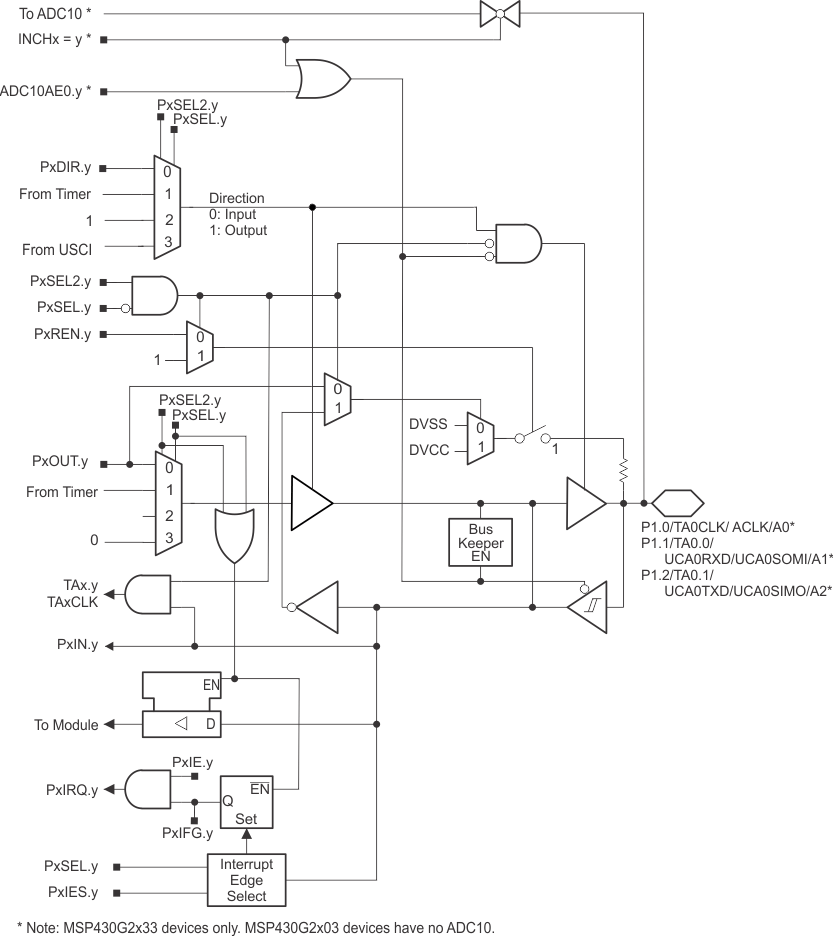 Figure 6-6 Port P1 (P1.0 to P1.2) Diagram
Figure 6-6 Port P1 (P1.0 to P1.2) Diagram
Table 6-16 Port P1 (P1.0 to P1.2) Pin Functions
| PIN NAME (P1.x) | x | FUNCTION | CONTROL BITS OR SIGNALS(1) | |||
|---|---|---|---|---|---|---|
| P1DIR.x | P1SEL.x | P1SEL2.x | ADC10AE.x (INCH.y = 1)(2) |
|||
| P1.0/ | 0 | P1.x (I/O) | I: 0; O: 1 | 0 | 0 | 0 |
| TA0CLK/ | TA0.TACLK | 0 | 1 | 0 | 0 | |
| ACLK/ | ACLK | 1 | 1 | 0 | 0 | |
| A0(2)/ | A0 | X | X | X | 1 (y = 0) | |
| Pin Osc | Capacitive sensing | X | 0 | 1 | 0 | |
| P1.1/ | 1 | P1.x (I/O) | I: 0; O: 1 | 0 | 0 | 0 |
| TA0.0/ | TA0.0 | 1 | 1 | 0 | 0 | |
| TA0.CCI0A | 0 | 1 | 0 | 0 | ||
| UCA0RXD/ | UCA0RXD | from USCI | 1 | 1 | 0 | |
| UCA0SOMI/ | UCA0SOMI | from USCI | 1 | 1 | 0 | |
| A1(2)/ | A1 | X | X | X | 1 (y = 1) | |
| Pin Osc | Capacitive sensing | X | 0 | 1 | 0 | |
| P1.2/ | 2 | P1.x (I/O) | I: 0; O: 1 | 0 | 0 | 0 |
| TA0.1/ | TA0.1 | 1 | 1 | 0 | 0 | |
| TA0.CCI1A | 0 | 1 | 0 | 0 | ||
| UCA0TXD/ | UCA0TXD | from USCI | 1 | 1 | 0 | |
| UCA0SIMO/ | UCA0SIMO | from USCI | 1 | 1 | 0 | |
| A2(2)/ | A2 | X | X | X | 1 (y = 2) | |
| Pin Osc | Capacitive sensing | X | 0 | 1 | 0 | |
6.10.2 Port P1 Pin Diagram: P1.3, Input/Output With Schmitt Trigger
Figure 6-7 shows the port diagram. Table 6-17 summarizes the selection of the pin functions.
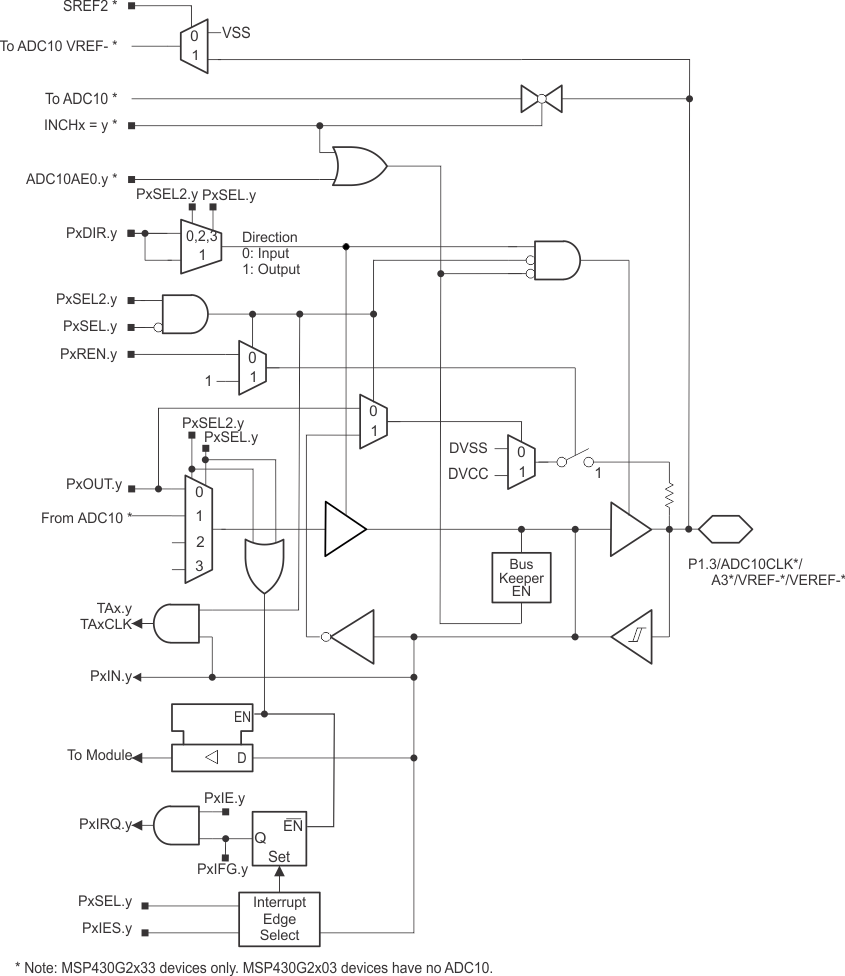 Figure 6-7 Port P1 (P1.3) Diagram
Figure 6-7 Port P1 (P1.3) Diagram
Table 6-17 Port P1 (P1.3) Pin Functions
| PIN NAME (P1.x) | x | FUNCTION | CONTROL BITS OR SIGNALS(1) | |||
|---|---|---|---|---|---|---|
| P1DIR.x | P1SEL.x | P1SEL2.x | ADC10AE.x (INCH.y = 1)(2) |
|||
| P1.3/ | 3 | P1.x (I/O) | I: 0; O: 1 | 0 | 0 | 0 |
| ADC10CLK(2)/ | ADC10CLK | 1 | 1 | 0 | 0 | |
| A3(2)/ | A3 | X | X | X | 1 (y = 3) | |
| VREF-(2)/ | VREF- | X | X | X | 1 | |
| VEREF-(2)/ | VEREF- | X | X | X | 1 | |
| Pin Osc | Capacitive sensing | X | 0 | 1 | 0 | |
6.10.3 Port P1 Pin Diagram: P1.4, Input/Output With Schmitt Trigger
Figure 6-8 shows the port diagram. Table 6-18 summarizes the selection of the pin functions.
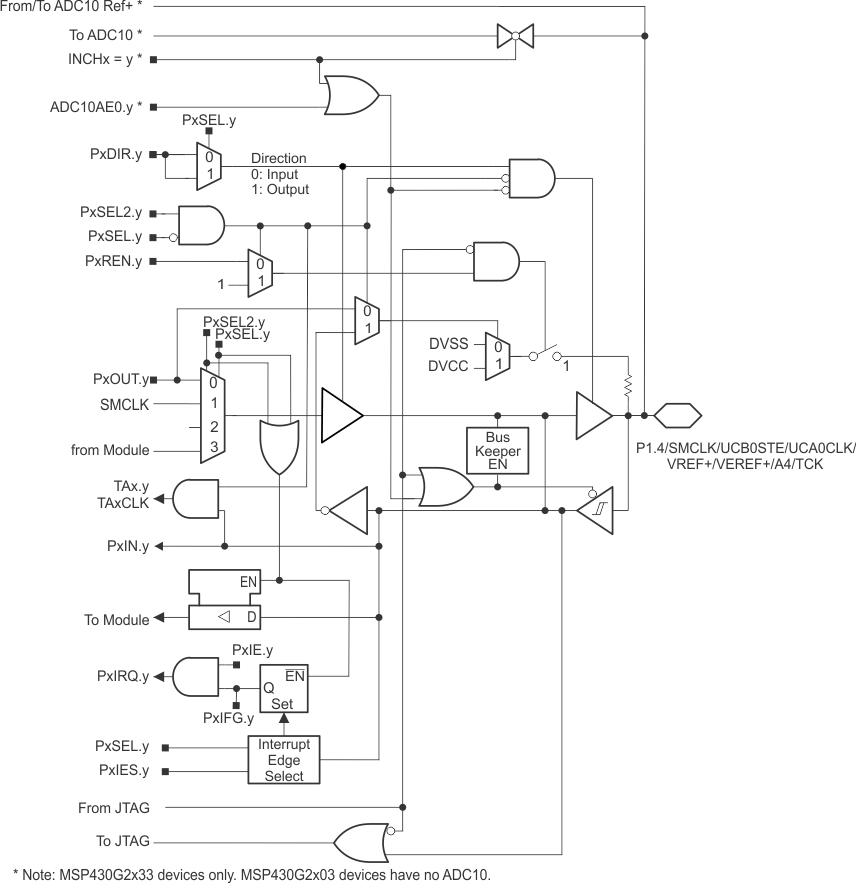 Figure 6-8 Port P1 (P1.4) Diagram
Figure 6-8 Port P1 (P1.4) Diagram
Table 6-18 Port P1 (P1.4) Pin Functions
| PIN NAME (P1.x) | x | FUNCTION | CONTROL BITS OR SIGNALS(1) | ||||
|---|---|---|---|---|---|---|---|
| P1DIR.x | P1SEL.x | P1SEL2.x | ADC10AE.x (INCH.y = 1)(2) |
JTAG Mode | |||
| P1.4/ | 4 | P1.x (I/O) | I: 0; O: 1 | 0 | 0 | 0 | 0 |
| SMCLK/ | SMCLK | 1 | 1 | 0 | 0 | 0 | |
| UCB0STE/ | UCB0STE(1)(2) | from USCI | 1 | 1 | 0 | 0 | |
| UCA0CLK/ | UCA0CLK(1)(2) | from USCI | 1 | 1 | 0 | 0 | |
| VREF+(2)/ | VREF+ | X | X | X | 1 | 0 | |
| VEREF+(2)/ | VEREF+ | X | X | X | 1 | 0 | |
| A4(2)/ | A4 | X | X | X | 1 (y = 4) | 0 | |
| TCK/ | TCK | X | X | X | 0 | 1 | |
| Pin Osc | Capacitive sensing | X | 0 | 1 | 0 | 0 | |
6.10.4 Port P1 Pin Diagram: P1.5 to P1.7, Input/Output With Schmitt Trigger
Figure 6-9 shows the port diagram. Table 6-19 summarizes the selection of the pin functions.
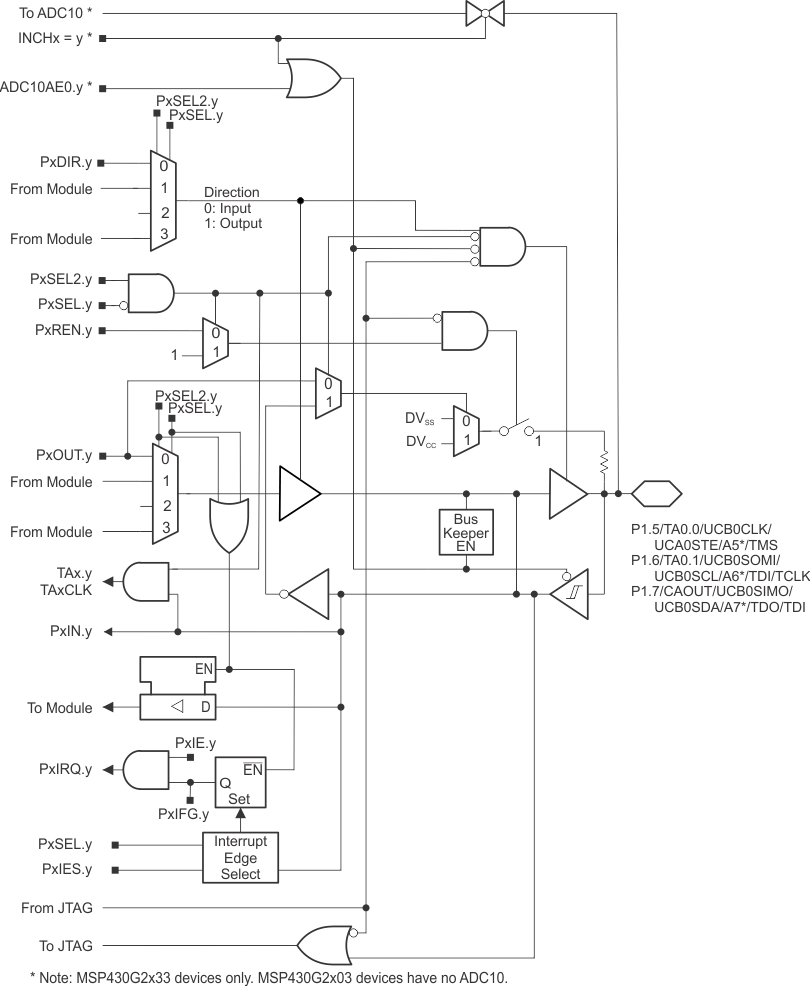 Figure 6-9 Port P1 (P1.5 to P1.7) Diagram
Figure 6-9 Port P1 (P1.5 to P1.7) Diagram
Table 6-19 Port P1 (P1.5 to P1.7) Pin Functions
| PIN NAME (P1.x) | x | FUNCTION | CONTROL BITS OR SIGNALS(1) | ||||
|---|---|---|---|---|---|---|---|
| P1DIR.x | P1SEL.x | P1SEL2.x | ADC10AE.x (INCH.y = 1)(2) |
JTAG Mode | |||
| P1.5/ | 5 | P1.x (I/O) | I: 0; O: 1 | 0 | 0 | 0 | 0 |
| TA0.0/ | TA0.0 | 1 | 1 | 0 | 0 | 0 | |
| UCB0CLK/ | UCB0CLK(1)(2) | from USCI | 1 | 1 | 0 | 0 | |
| UCA0STE/ | UCA0STE(1)(2) | from USCI | 1 | 1 | 0 | 0 | |
| A5(2)/ | A5 | X | X | X | 1 (y = 5) | 0 | |
| TMS | TMS | X | X | X | 0 | 1 | |
| Pin Osc | Capacitive sensing | X | 0 | 1 | 0 | 0 | |
| P1.6/ | 6 | P1.x (I/O) | I: 0; O: 1 | 0 | 0 | 0 | 0 |
| TA0.1/ | TA0.1 | 1 | 1 | 0 | 0 | 0 | |
| UCB0SOMI/ | UCB0SOMI | from USCI | 1 | 1 | 0 | 0 | |
| UCB0SCL/ | UCB0SCL | from USCI | 1 | 1 | 0 | 0 | |
| A6(2)/ | A6 | X | X | X | 1 (y = 6) | 0 | |
| TDI/TCLK/ | TDI/TCLK | X | X | X | 0 | 1 | |
| Pin Osc | Capacitive sensing | X | 0 | 1 | 0 | 0 | |
| P1.7/ | 7 | P1.x (I/O) | I: 0; O: 1 | 0 | 0 | 0 | 0 |
| UCB0SIMO/ | UCB0SIMO | from USCI | 1 | 1 | 0 | 0 | |
| UCB0SDA/ | UCB0SDA | from USCI | 1 | 1 | 0 | 0 | |
| A7(2)/ | A7 | X | X | X | 1 (y = 7) | 0 | |
| TDO/TDI/ | TDO/TDI | X | X | X | 0 | 1 | |
| Pin Osc | Capacitive sensing | X | 0 | 1 | 0 | 0 | |
6.10.5 Port P2 Pin Diagram: P2.0 to P2.5, Input/Output With Schmitt Trigger
Figure 6-10 shows the port diagram. Table 6-20 summarizes the selection of the pin functions.
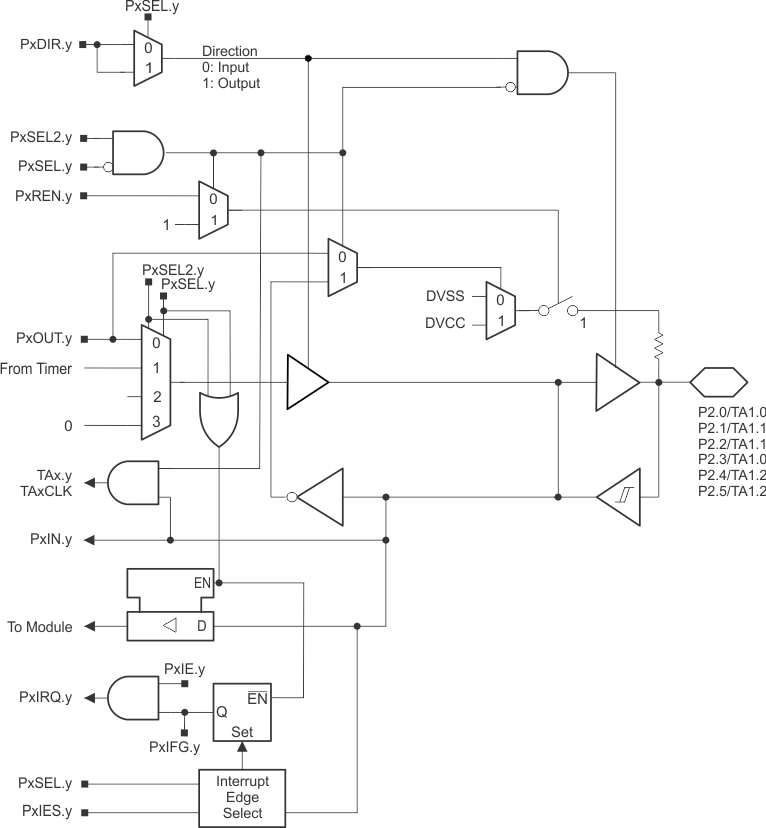 Figure 6-10 Port P2 (P2.0 to P2.5) Diagram
Figure 6-10 Port P2 (P2.0 to P2.5) Diagram
Table 6-20 Port P2 (P2.0 to P2.5) Pin Functions
| PIN NAME (P2.x) | x | FUNCTION | CONTROL BITS OR SIGNALS(1) | ||
|---|---|---|---|---|---|
| P2DIR.x | P2SEL.x | P2SEL2.x | |||
| P2.0/ | 0 | P2.x (I/O) | I: 0; O: 1 | 0 | 0 |
| TA1.0/ | Timer1_A3.CCI0A | 0 | 1 | 0 | |
| Timer1_A3.TA0 | 1 | 1 | 0 | ||
| Pin Osc | Capacitive sensing | X | 0 | 1 | |
| P2.1/ | 1 | P2.x (I/O) | I: 0; O: 1 | 0 | 0 |
| TA1.1/ | Timer1_A3.CCI1A | 0 | 1 | 0 | |
| Timer1_A3.TA1 | 1 | 1 | 0 | ||
| Pin Osc | Capacitive sensing | X | 0 | 1 | |
| P2.2/ | 2 | P2.x (I/O) | I: 0; O: 1 | 0 | 0 |
| TA1.1/ | Timer1_A3.CCI1B | 0 | 1 | 0 | |
| Timer1_A3.TA1 | 1 | 1 | 0 | ||
| Pin Osc | Capacitive sensing | X | 0 | 1 | |
| P2.3/ | 3 | P2.x (I/O) | I: 0; O: 1 | 0 | 0 |
| TA1.0/ | Timer1_A3.CCI0B | 0 | 1 | 0 | |
| Timer1_A3.TA0 | 1 | 1 | 0 | ||
| Pin Osc | Capacitive sensing | X | 0 | 1 | |
| P2.4/ | 4 | P2.x (I/O) | I: 0; O: 1 | 0 | 0 |
| TA1.2/ | Timer1_A3.CCI2A | 0 | 1 | 0 | |
| Timer1_A3.TA2 | 1 | 1 | 0 | ||
| Pin Osc | Capacitive sensing | X | 0 | 1 | |
| P2.5/ | 5 | P2.x (I/O) | I: 0; O: 1 | 0 | 0 |
| TA1.2/ | Timer1_A3.CCI2B | 0 | 1 | 0 | |
| Timer1_A3.TA2 | 1 | 1 | 0 | ||
| Pin Osc | Capacitive sensing | X | 0 | 1 | |
6.10.6 Port P2 Pin Diagram: P2.6, Input/Output With Schmitt Trigger
Figure 6-11 shows the port diagram. Table 6-21 summarizes the selection of the pin functions.
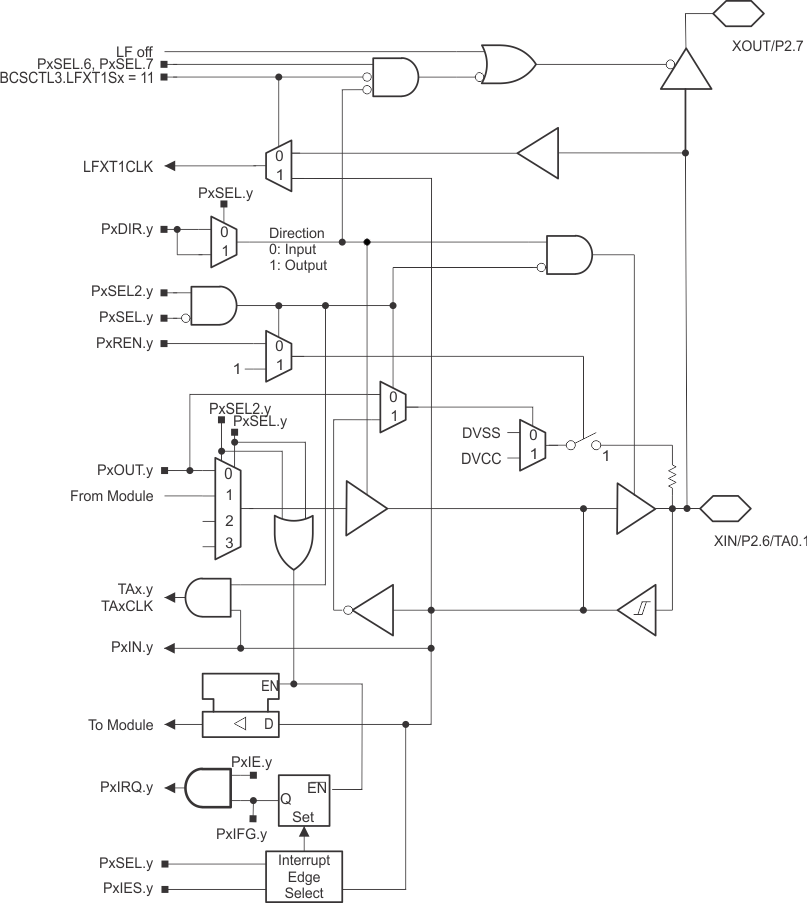 Figure 6-11 Port P2 (P2.6) Diagram
Figure 6-11 Port P2 (P2.6) Diagram
Table 6-21 Port P2 (P2.6) Pin Functions
| PIN NAME (P2.x) | x | FUNCTION | CONTROL BITS OR SIGNALS(1) | ||
|---|---|---|---|---|---|
| P2DIR.x | P2SEL.6 P2SEL.7 |
P2SEL2.6 P2SEL2.7 |
|||
| XIN | 6 | XIN | 0 | 1 1 |
0 0 |
| P2.6 | P2.x (I/O) | I: 0; O: 1 | 0 X |
0 0 |
|
| TA0.1 | Timer0_A3.TA1 | 1 | 1 0 |
0 0 |
|
| Pin Osc | Capacitive sensing | X | 0 X |
1 X |
|
6.10.7 Port P2 Pin Diagram: P2.7, Input/Output With Schmitt Trigger
Figure 6-12 shows the port diagram. Table 6-22 summarizes the selection of the pin functions.
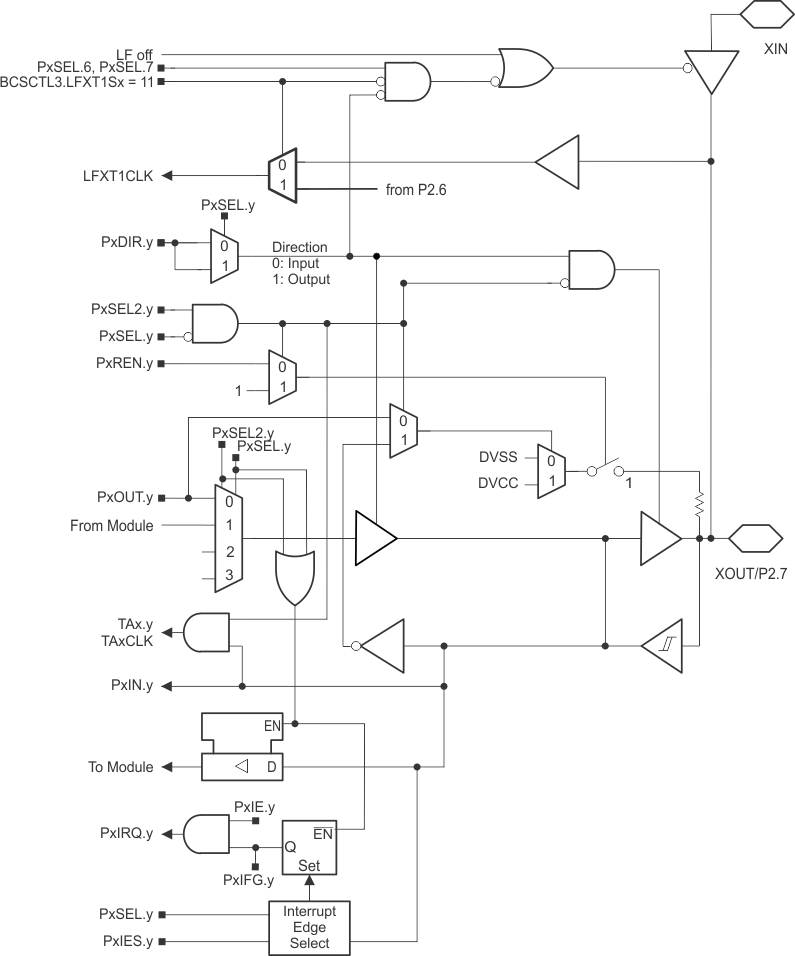 Figure 6-12 Port P2 (P2.7) Diagram
Figure 6-12 Port P2 (P2.7) Diagram
Table 6-22 Port P2 (P2.7) Pin Functions
| PIN NAME (P2.x) | x | FUNCTION | CONTROL BITS OR SIGNALS(1) | ||
|---|---|---|---|---|---|
| P2DIR.x | P2SEL.6 P2SEL.7 |
P2SEL2.6 P2SEL2.7 |
|||
| XOUT/ | 7 | XOUT | 1 | 1 1 |
0 0 |
| P2.7/ | P2.x (I/O) | I: 0; O: 1 | 0 X |
0 0 |
|
| Pin Osc | Capacitive sensing | X | 0 X |
1 X |
|
6.10.8 Port P3 Pin Diagram: P3.0 to P3.7, Input/Output With Schmitt Trigger (RHB and PW28 Package Only)
Figure 6-13 shows the port diagram. Table 6-23 summarizes the selection of the pin functions.
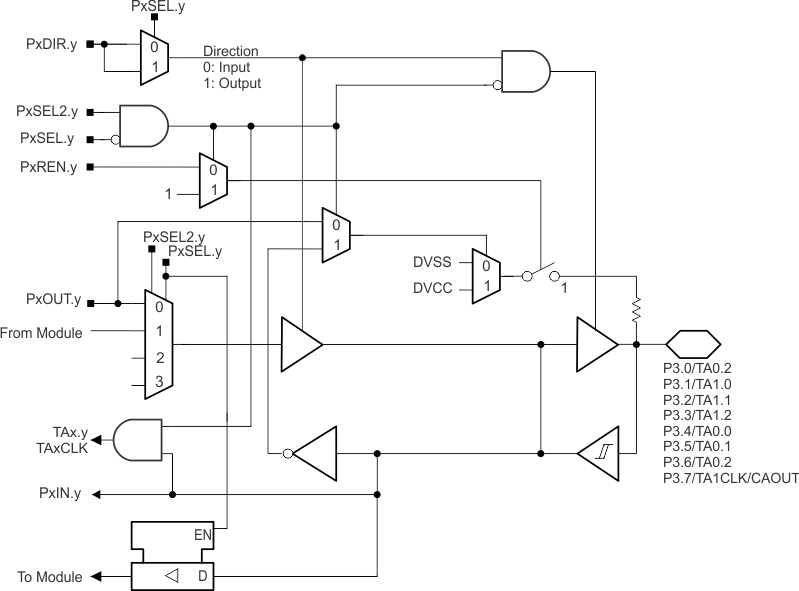 Figure 6-13 Port P3 (P3.0 to P3.7) Diagram (RHB and PW28 Package Only)
Figure 6-13 Port P3 (P3.0 to P3.7) Diagram (RHB and PW28 Package Only)
Table 6-23 Port P3 (P3.0 to P3.7) Pin Functions (RHB and PW28 Package Only)
| PIN NAME (P3.x) | x | FUNCTION | CONTROL BITS OR SIGNALS(1) | ||
|---|---|---|---|---|---|
| P3DIR.x | P3SEL.x | P3SEL2.x | |||
| P3.0/ | 0 | P3.x (I/O) | I: 0; O: 1 | 0 | 0 |
| TA0.2/ | Timer0_A3.CCI2A | 0 | 1 | 0 | |
| Timer0_A3.TA2 | 1 | 1 | 0 | ||
| Pin Osc | Capacitive sensing | X | 0 | 1 | |
| P3.1/ | 1 | P3.x (I/O) | I: 0; O: 1 | 0 | 0 |
| TA1.0/ | Timer1_A3.TA0 | 1 | 1 | 0 | |
| Pin Osc | Capacitive sensing | X | 0 | 1 | |
| P3.2/ | 2 | P3.x (I/O) | I: 0; O: 1 | 0 | 0 |
| TA1.1/ | Timer1_A3.TA1 | 1 | 1 | 0 | |
| Pin Osc | Capacitive sensing | X | 0 | 1 | |
| P3.3/ | 3 | P3.x (I/O) | I: 0; O: 1 | 0 | 0 |
| TA1.2/ | Timer1_A3.TA2 | 1 | 1 | 0 | |
| Pin Osc | Capacitive sensing | X | 0 | 1 | |
| P3.4/ | 4 | P3.x (I/O) | I: 0; O: 1 | 0 | 0 |
| TA0.0/ | Timer0_A3.TA0 | 1 | 1 | 0 | |
| Pin Osc | Capacitive sensing | X | 0 | 1 | |
| P3.5/ | 5 | P3.x (I/O) | I: 0; O: 1 | 0 | 0 |
| TA0.1/ | Timer0_A3.TA1 | 1 | 1 | 0 | |
| Pin Osc | Capacitive sensing | X | 0 | 1 | |
| P3.6/ | 6 | P3.x (I/O) | I: 0; O: 1 | 0 | 0 |
| TA0.2/ | Timer0_A3.TA2 | 1 | 1 | 0 | |
| Pin Osc | Capacitive sensing | X | 0 | 1 | |
| P3.7/ | 7 | P3.x (I/O) | I: 0; O: 1 | 0 | 0 |
| TA1CLK/ | Timer1_A3.TACLK | 0 | 1 | 0 | |
| Pin Osc | Capacitive sensing | X | 0 | 1 | |